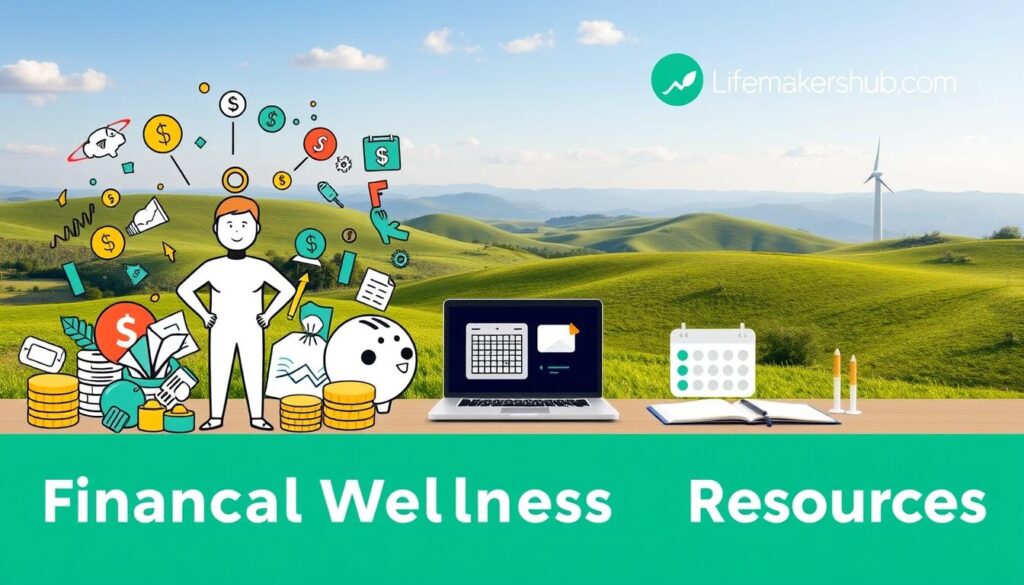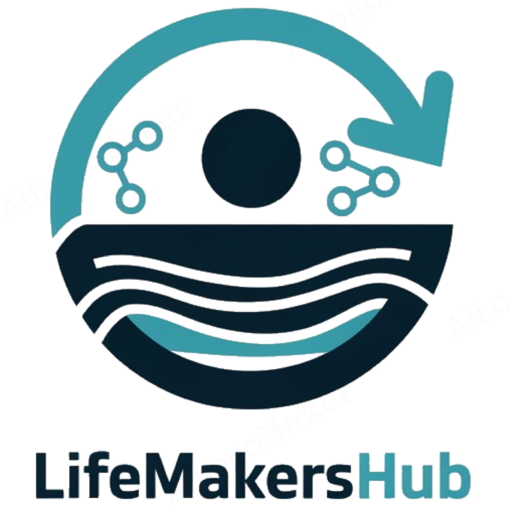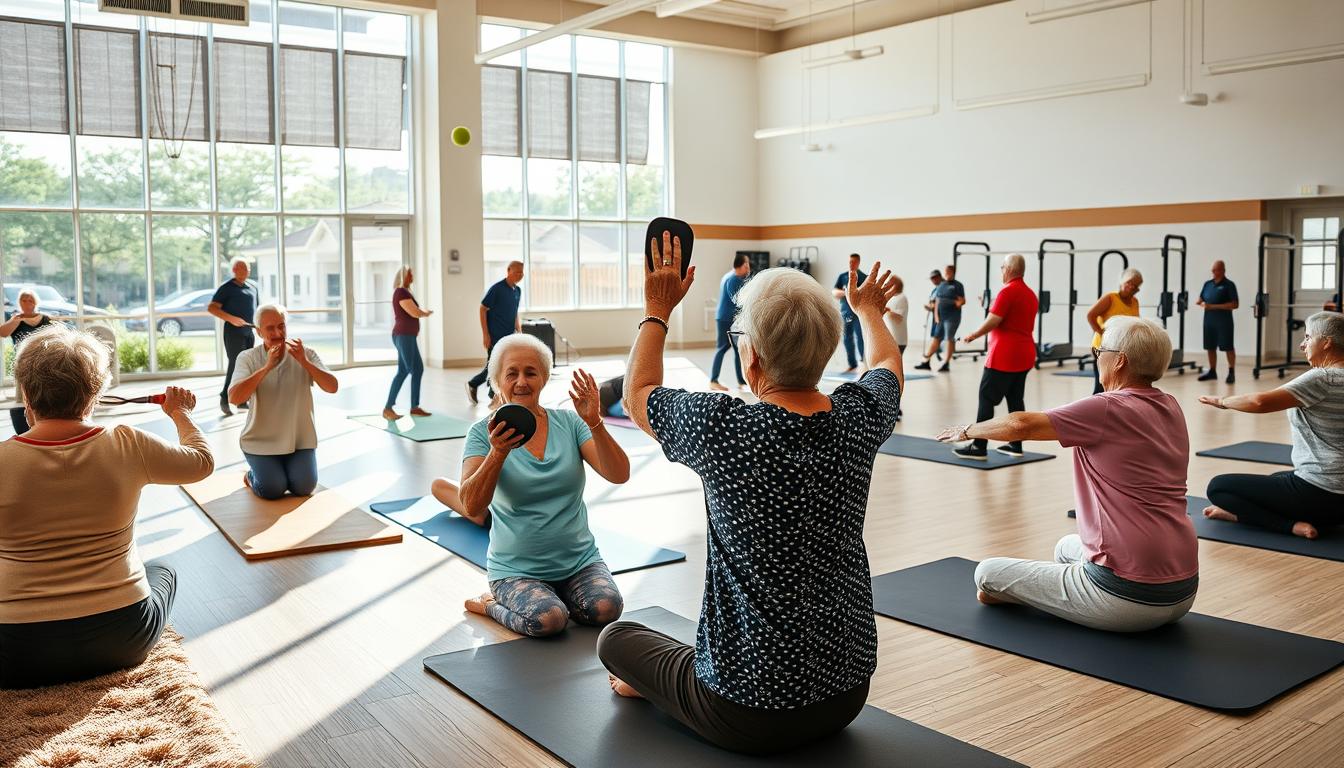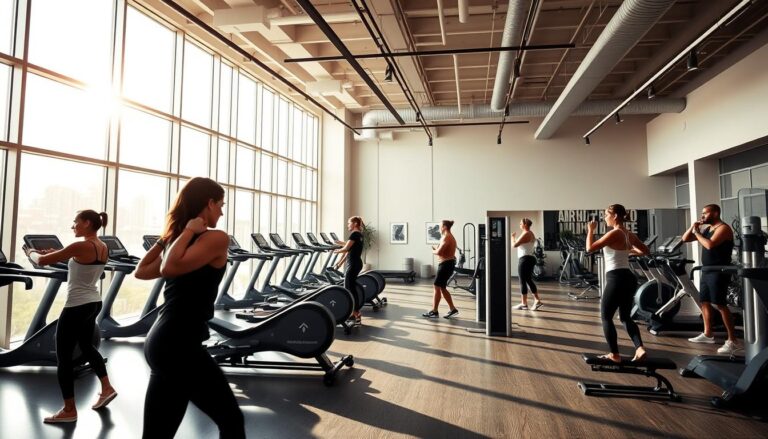Wellness Resources to Enhance Your Health & Vitality
Many of us dream of big health changes, like quitting smoking or changing our diets. But, wellness resources make these goals feel less daunting. They offer practical tools and programs to help you build better habits gradually. Whether it’s fitness classes or mental health support, these resources help you improve your health without making huge changes.
For example, seniors can benefit from just 150 minutes of moderate exercise each week. Programs like SilverSneakers can help them get stronger and reduce the risk of falls. Free classes in local parks or online videos for older adults make it easy to stay active. Tools like nutrition workshops or mindfulness practices also help make small but significant changes in your daily life.
Health tips and wellness resources work best when they fit your lifestyle. You can find them through your employer, community centers, or apps. This guide shows how wellness resources, from team-building challenges to financial wellness programs, help you find balance without extreme efforts. Discover how small steps with the right tools can change your life.
Key Takeaways
- Wellness resources provide accessible tools to improve health through manageable steps.
- Programs like SilverSneakers and local parks classes offer affordable options for seniors.
- Health screenings and nutrition workshops reduce risks and boost energy naturally.
- Community support and mindfulness practices enhance mental and emotional well-being.
- Small changes, like 150 weekly minutes of exercise, lead to measurable health improvements.
Understanding Wellness Resources
Wellness resources are tools and support systems that help you take control of your health. They can be physical items like exercise equipment or digital apps that track sleep patterns. Knowing what options are available helps you choose what fits your lifestyle.
Definition of Wellness Resources
Wellness resources include anything that promotes physical, mental, and emotional health. For example:
- Fitness equipment or yoga mats
- Guides like SAMHSA’s mental health hotline information
- Nutrition plans from the International Association of Fire Fighters
These resources help turn wellness goals into steps you can take. Whether it’s tracking sleep with Brigham Health’s tools or following Harvard’s Mediterranean diet guides, they guide you.
Importance of Wellness in Daily Life
Incorporating wellness resources improves your long-term health. Small changes, like getting 7-9 hours of sleep, can boost well-being by 20%. Wellness articles can lead you to heart-healthy diets, reducing disease risk by up to 50%.
Even routine check-ups can cut ER visits by 40%. Accessing these resources builds resilience. SAMHSA’s 24/7 helpline supports mental health, while sleep apps help shift workers. Every choice, from mindful eating to stress management, adds up to lasting benefits.
Types of Wellness Resources
Wellness resources cover many areas, each focusing on different health aspects. Look through these categories to craft a wellness plan that fits your needs.
Strong social connections can improve both emotional and physical health, as shown by research linking relationships to longer, healthier lives.
Physical Wellness Resources
Physical resources include tools like free exercise libraries from the American Council on Exercise and National Academy of Sports Medicine. Apps like Fitness Blender guide workouts. Ergonomic tools also help reduce work strain. These tools boost strength and energy.
Mental Wellness Resources
Find mental wellness resources like SAMHSA’s 24/7 helpline (1-800-662-4357) or apps like Headspace for mindfulness. The American Psychological Association offers 12 stress tools to build emotional strength.
Nutritional Wellness Resources
Nutritional support includes meal planning services like MyFitnessPal and guides from the Sleep Foundation on diet and rest. Nutritionists and cooking classes teach how food affects energy and vitality.
Social Wellness Resources
Join community groups or use directories like Meetup.com to build social bonds. The National Wellness Institute’s Six Dimensions model highlights the importance of social ties for overall health. It combines emotional and occupational well-being.
Check out a wellness resources directory for local gyms, counseling, or nutritionists. Holistic health resources cover all areas, ensuring balance in your life. By picking resources that match your goals, you lay a solid foundation for lasting wellness.
Benefits of Utilizing Wellness Resources
Wellness resources and health tips can change your life. Studies show that combining care and lifestyle changes boosts health. For example, companies with wellness programs see a 30% increase in productivity. Plus, 90% of workers feel happier at work.
Improved Overall Health
Using wellness resources regularly strengthens your health. Preventive steps like blood pressure checks and nutrition advice lower disease risks. A 2023 study found that participants spent $1,384 less on medical care each year.
- 72% of employers see lower healthcare costs
- Biometric screenings catch issues early, leading to better outcomes
- Health monitoring can increase life expectancy
Enhanced Mental Clarity
Wellness tools like mindfulness apps and stress management sharpen your mind. Over 87% of workers value employers who support mental health. These programs reduce brain fog and enhance focus through:
- Meditation guides and counseling access
- Stress-reduction workshops
- Personalized health tips for better decision-making
Increased Energy Levels
Wellness resources boost energy by improving sleep and nutrition. Companies see a 30% productivity boost with tools like fitness classes. Benefits include:
- Improved sleep quality from wellness tips
- Energy management strategies reducing fatigue
- Corporate wellness programs cut absenteeism by 20%
| Outcome | Impact |
|---|---|
| Employee Satisfaction | 90% report higher job satisfaction |
| Medical Savings | $1,384 average annual cost reduction |
| Engagement | 83% of companies offer weekly wellness activities |
Wellness resources benefit everyone, no matter age. Small actions like daily walks or mindfulness add up. They build resilience and promote a healthier lifestyle. Start today to enjoy these benefits.
Finding Local Wellness Resources
Looking for wellness resources in your area? Start by checking out community-based options. You might find fitness classes, nutrition advice, or mental health support close to home. Visit your city’s website or check community boards for affordable programs like fitness workshops or nutrition counseling.
Community Centers and Programs
Local community centers, like YMCAs or senior centers, offer free or low-cost wellness programs. For example, Kaiser Permanente members can find wellness classes in their directory. Your city’s recreation department might list yoga sessions or stress management workshops.
SAMHSA’s National Helpline (1-800-662-HELP) can connect you to mental health services near you. NAMI chapters also offer support groups in your area.
Gyms and Fitness Studios
Choosing a gym? Look for certified trainers and equipment that fits your goals. Compare different membership options and try out a studio for a week. Many gyms offer a free trial for new members.
Check reviews for gyms that focus on functional training, especially for first responders. Some gyms might partner with programs like Harvard’s Mediterranean diet initiatives.
Health Food Stores
Health food stores like Whole Foods or local co-ops sell organic foods and supplements. They often host seminars or cooking classes with nutritionists or local chefs. These stores can provide guides on meal planning or diets for allergies, helping you on your health journey.
Online Wellness Resources
Online wellness resources offer flexible ways to focus on health from anywhere. You can find virtual platforms, articles, and apps to track your progress. These tools help you get guidance and connect with experts. Let’s see how they can fit into your daily routine.
Virtual Fitness Classes
Watch live or on-demand workouts on YouTube channels like Yoga with Adriene or Fitness Blender. Peloton offers guided sessions, and HBO’s #StayHomeBoxOffice has free fitness content. These options save you time and money.
- Yoga with Adriene: Free YouTube library
- Fitness Blender: 500+ free home workouts
- Peloton Digital: $19.49/month for live classes
Wellness Blogs and Websites
Stay updated with wellness articles from trusted sources. The CDC has guides for stress management, and Psychology Tools offers free resources for anxiety. Check out the New York Times’ At Home section for wellness ideas.
| Website | Focus |
|---|---|
| CDC | Stress coping strategies |
| JED Foundation | COVID-19 mental health tips |
| Therapy for Black Girls | Community support + podcast |
Nutrition Apps
Use apps like MyFitnessPal or Noom to track meals and goals. MyFitnessPal’s barcode scanner makes logging easy, and Noom uses science to create plans. Free apps like the CBD Thought Diary and WoeBot help with mood and mental health.
Combine these tools with virtual classes and articles for a complete wellness plan. Choose apps that match your goals and check sources for accuracy.
Financial Wellness Resources

Managing your finances is crucial for long-term health. Financial stress affects 54% of workers, leading to poor mental and physical health, as PwC’s 2020 report shows. Start by budgeting wisely. Use free tools like Peach or NerdWallet to track your spending and focus on health investments.
Budgeting for Health and Wellness
- Explore apps like Empower or PlansWell to create budgets for your health goals.
- Use Texas One Stop’s Cost of Attendance calculator to plan for education without neglecting wellness.
- Follow MyMoney.gov’s “spending” tips to avoid debt and fund fitness or healthy food.
Insurance Options for Wellness Programs
Maximize coverage through:
- Employer wellness programs offering discounted gym memberships or mental health support.
- Insurance plans covering preventive care, like vaccines or screenings, via the Affordable Care Act.
- Resources like Dollar For to negotiate medical bills or access charity care programs.
Link financial literacy with health goals. The Consumer Financial Protection Bureau’s questionnaire helps assess financial well-being. NEFE’s CashCourse guides students in balancing budgets and health needs. Remember, financial stability is key to lasting wellness.
Wellness Resources for Stress Management
Managing stress is essential, not a luxury. It can lead to serious health issues like heart disease and anxiety. But, self-care advice and wellness tools can help. Start with simple solutions that fit into your daily life.
Mindfulness and Meditation Tools
Start with tools to calm your mind. Apps like Headspace and Calm offer short guided sessions. You can also find free mindful breathing exercises on YouTube. Just 2 minutes of deep breathing can calm your nervous system.
Yoga and Relaxation Techniques
Yoga is more than physical exercise; it’s a mental reset. Try these quick tips:
- Free online yoga flows for stress relief (search “yoga for anxiety”)
- Progressive muscle relaxation: Tense and release muscles from toes to head
- Box breathing: Inhale 4 counts, hold 4, exhale 4—repeat 3x
“Laughter boosts immunity and lowers blood pressure,” says research. Humor is free self-care advice. Watch a funny video or chat with a friend to shift your mood.
Stress can mess with your sleep, creating a cycle. The MHealthy Sleep Resources course teaches bedtime routines to break this cycle. For farmers and ranchers, the FARM AID HOTLINE (1-800-FARM-AID) offers free counseling to address work-related stress.
Even small steps can make a difference. Swap that third coffee for herbal tea. A 10-minute walk or petting your dog can reset your day. Your health depends on it.
Integrative Wellness Approaches
Integrative wellness combines traditional medicine with holistic health resources and wellness resources. It offers personalized care that looks at your whole well-being. This mix of old and new methods helps balance your body, mind, and spirit.
Holistic Health Practices
Discover ways to see your body as a whole:
- Acupuncture: Helps with pain and nausea, lasting 45–60 minutes.
- Massage therapy: Reduces stress and anxiety, great for fibromyalgia.
- Yoga and mindfulness: Boosts flexibility and focus, lowers stress.
- Herbal remedies: Always check with experts to avoid drug interactions.
Mayo Clinic and New Hope Mental Health Clinic mix therapies like acupuncture with counseling. This shows how old and new methods can work together. Even simple actions like stretching can add ancient wellness to your day.
Traditional vs. Modern Wellness
Find a balance between old and new:
- Traditional: Ayurveda or daily stretching focus on natural balance.
- Modern: CBT or fitness apps offer structured help.
- Integration: Mix yoga with CBT for anxiety, or herbal consultations with doctor-approved treatments.
Always put safety first. Talk to your doctor about any therapies to make sure they’re safe for you. Whether it’s an app for meditation or acupuncture, your plan should match your needs and likes.
Wellness Resources for Chronic Conditions
Living with chronic conditions like diabetes or heart disease needs special wellness resources. Since 2003, the Administration on Aging (AoA) has spent millions on Chronic Disease Self-Management Education programs. These efforts help over 250,000 people across the country manage their health better.
61% of participants in AoA programs manage multiple chronic conditions, including diabetes, hypertension, and arthritis.
Diabetes Management Tools
- Glucose monitoring devices with real-time tracking features
- Certified diabetes educators offering personalized meal planning
- Online communities like the American Diabetes Association’s directory
Heart Health Strategies
Start by keeping saltshakers out of sight and taste food before adding salt. The AoA’s 2024 grants of $5.66 million support heart-healthy programs like:
- Low-sodium recipe guides
- Cardiac rehabilitation programs
- Blood pressure monitoring kits
| Year | Funding Awarded |
|---|---|
| 2024 | $5,660,692 |
| 2023 | $4,793,731 |
| 2022 | $6,000,000 |
Check out the AoA’s wellness resources directory for local programs. Since 2010, over 370,000 people have seen their health improve. Combine these resources with yearly doctor visits for the best care.
Corporate Wellness Programs

Corporate wellness programs are changing the workplace by focusing on employee health. SHRM says 41% of employers now offer wellness resources. This shows how important it’s becoming. These programs cut healthcare costs, increase productivity, and help attract the best employees. Let’s look at how these programs work and how you can get involved.
Benefits of Workplace Wellness Initiatives
Online and in-person wellness resources have big effects. Companies with strong wellness programs did 3–5% better than the S&P 500 from 1997–2012. The main benefits are:
- Lower healthcare costs from preventive care
- Less time off for health reasons
- Keeping employees longer because they’re happier
Creating a Healthy Workplace Culture
To build a wellness-focused culture, take these steps:
Next time you’re at your desk, adjust your posture: straighten your back, tuck your stomach, and place feet flat on the floor. This simple change can prevent back pain and strain.
Employers can do things like:
- Make workspaces ergonomic to lower injury risks
- Do health screenings twice a year
- Teach nutrition through the cafeteria menu
| Type | Examples | Requirements |
|---|---|---|
| Participatory | Free gym access, wellness workshops | No health outcomes required |
| Health-Contingent | Smoking cessation rewards | Meet specific health goals |
It’s key to take care of yourself. PERS programs give $100 Visa cards for health assessments. You can ask for ergonomic changes and wellness stipends for fitness or mental health days. Making small changes now can lead to big health benefits for you and your workplace.
Building a Personal Wellness Plan
Creating a wellness plan starts with knowing what you need. Use these health tips and self-care advice to make a plan that fits your life. First, look at your habits in physical activity, mental health, and social life.
75% of successful individuals use the SMART framework to stay on track with their goals.
Steps to Develop Your Wellness Plan
- Check how you’re doing physically, mentally, and emotionally
- Pick 2-3 key areas to focus on (like exercise or managing stress)
- Look into resources like fitness apps or therapy
- Make a weekly plan with daily tasks
- Have monthly check-ins to make changes if needed
Setting Achievable Wellness Goals
Follow these self-care advice tips for success:
- Specific: “Walk 10,000 steps daily” instead of “be more active”
- Measurable: Use a wearable to track sleep hours
- Time-bound: Try to sleep for 7 hours for 3 nights this week
Start with small steps like taking the stairs or short mindfulness breaks. Remember, it’s about being consistent, not perfect. Change your goals as your life changes.
Tracking Your Wellness Journey
Keeping track of your progress is crucial for sticking to wellness goals. Using wellness tools and reflecting regularly helps keep your efforts focused. Whether it’s through technology or a journal, tracking turns vague goals into concrete actions.
Tools to Monitor Progress
Today’s wellness tools make tracking easier. Wearables like Fitbit or Apple Watch track steps, heart rate, and sleep. Apps like MyFitnessPal or MyPlate App help you log what you eat and its nutrients.
Apps like Daylio or Moodfit connect mood swings to daily habits, offering insights into mental health patterns. Platforms like Nike Training Club or Habit Tracker App let you set reminders and review trends visually. Adding annual doctor visits for blood pressure or BMI checks adds a clinical touch to your self-assessment.
Reflection and Adjustment Strategies
Review your data weekly to spot trends. Did sleep dips correlate with stress? Did exercise boosts improve mood? Adjust your goals based on these insights.
The Rush study shows that mental exercises like journaling—using apps like Gratitude or Worry Watch—strengthen cognitive health while aiding reflection. If progress stalls, tweak routines: swap a strenuous workout for yoga, or explore Plant Nanny for hydration reminders.
Your journey isn’t static. Use wellness articles to discover new strategies and stay motivated. Whether through wearable devices, apps, or simple journals, tracking keeps you mindful of progress. Celebrate small wins—like a month of consistent walks—and let data guide your next steps. Wellness evolves, and so should your approach. Stay flexible, stay curious, and let every adjustment bring you closer to lasting vitality.
FAQ
What are wellness resources?
How can I incorporate wellness practices into my daily life?
Why is mental wellness important?
What types of wellness resources are available for physical health?
How can wellness resources enhance my energy levels?
Where can I find affordable local wellness resources?
What digital wellness resources can I use?
How can I manage wellness expenses effectively?
Are there specific resources for managing stress?
How can I create a personalized wellness plan?
What methods can I use to track my wellness progress?
Source Links
- 6 Great Examples of Workplace Wellness Programs
- Health and Wellness Programs for Seniors to Boost Vitality
- Wellness Resources and Strategies
- Wellness Resources | University Health Services
- Wellness Resources and Strategies
- Six Dimensions of Wellness – National Wellness Institute
- Mental Health and Wellness Resources
- 10 Benefits of Employee Wellness Programs | Wellable
- What do Workplace Wellness Programs do? Evidence from the Illinois Workplace Wellness Study
- Help for Mental Illnesses
- Online Wellness Resources | National University
- Virtual Wellness Resources
- Online Wellness Resources | GMHCN
- Financial Wellness Resources to Support Employees
- Resources – Financial Wellness
- Resources: Financial Wellness – Northwestern University
- Stress Management Tools and Resources
- Manage Your Stress – Extension Wellness
- Holistic Approaches to Mental Wellness: Integrating Body, Mind, and Spirit
- Integrative Medicine and Health – Overview
- Chronic Disease Self-Management Education Programs
- Health resources
- Designing and Managing Wellness Programs
- Workplace Wellness
- Building a Personal Wellness Plan: A Step-by-Step Guide
- Creating a Personal Wellness Plan – Tangible Movement
- Personal Wellness Plan
- Tracking Progress for Physical Wellness Goals
- Top 10 FREE Resources for Achieving Your Wellness Goals
- 10 Resources for Tracking and Improving Your Mental Health







